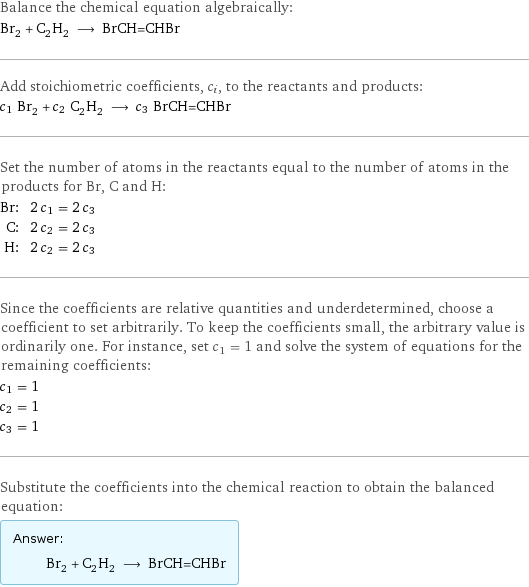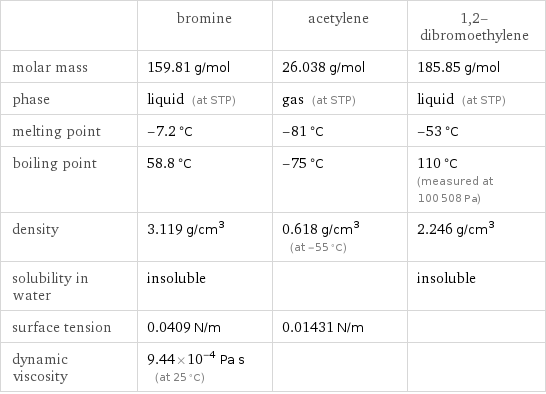Input interpretation

Br_2 bromine + C_2H_2 acetylene ⟶ BrCH=CHBr 1, 2-dibromoethylene
Balanced equation

Balance the chemical equation algebraically: Br_2 + C_2H_2 ⟶ BrCH=CHBr Add stoichiometric coefficients, c_i, to the reactants and products: c_1 Br_2 + c_2 C_2H_2 ⟶ c_3 BrCH=CHBr Set the number of atoms in the reactants equal to the number of atoms in the products for Br, C and H: Br: | 2 c_1 = 2 c_3 C: | 2 c_2 = 2 c_3 H: | 2 c_2 = 2 c_3 Since the coefficients are relative quantities and underdetermined, choose a coefficient to set arbitrarily. To keep the coefficients small, the arbitrary value is ordinarily one. For instance, set c_1 = 1 and solve the system of equations for the remaining coefficients: c_1 = 1 c_2 = 1 c_3 = 1 Substitute the coefficients into the chemical reaction to obtain the balanced equation: Answer: | | Br_2 + C_2H_2 ⟶ BrCH=CHBr
Structures

+ ⟶
Names

bromine + acetylene ⟶ 1, 2-dibromoethylene
Equilibrium constant
![Construct the equilibrium constant, K, expression for: Br_2 + C_2H_2 ⟶ BrCH=CHBr Plan: • Balance the chemical equation. • Determine the stoichiometric numbers. • Assemble the activity expression for each chemical species. • Use the activity expressions to build the equilibrium constant expression. Write the balanced chemical equation: Br_2 + C_2H_2 ⟶ BrCH=CHBr Assign stoichiometric numbers, ν_i, using the stoichiometric coefficients, c_i, from the balanced chemical equation in the following manner: ν_i = -c_i for reactants and ν_i = c_i for products: chemical species | c_i | ν_i Br_2 | 1 | -1 C_2H_2 | 1 | -1 BrCH=CHBr | 1 | 1 Assemble the activity expressions accounting for the state of matter and ν_i: chemical species | c_i | ν_i | activity expression Br_2 | 1 | -1 | ([Br2])^(-1) C_2H_2 | 1 | -1 | ([C2H2])^(-1) BrCH=CHBr | 1 | 1 | [BrCH=CHBr] The equilibrium constant symbol in the concentration basis is: K_c Mulitply the activity expressions to arrive at the K_c expression: Answer: | | K_c = ([Br2])^(-1) ([C2H2])^(-1) [BrCH=CHBr] = ([BrCH=CHBr])/([Br2] [C2H2])](../image_source/edb0379d02cd440c3ed4358c16c3cdbb.png)
Construct the equilibrium constant, K, expression for: Br_2 + C_2H_2 ⟶ BrCH=CHBr Plan: • Balance the chemical equation. • Determine the stoichiometric numbers. • Assemble the activity expression for each chemical species. • Use the activity expressions to build the equilibrium constant expression. Write the balanced chemical equation: Br_2 + C_2H_2 ⟶ BrCH=CHBr Assign stoichiometric numbers, ν_i, using the stoichiometric coefficients, c_i, from the balanced chemical equation in the following manner: ν_i = -c_i for reactants and ν_i = c_i for products: chemical species | c_i | ν_i Br_2 | 1 | -1 C_2H_2 | 1 | -1 BrCH=CHBr | 1 | 1 Assemble the activity expressions accounting for the state of matter and ν_i: chemical species | c_i | ν_i | activity expression Br_2 | 1 | -1 | ([Br2])^(-1) C_2H_2 | 1 | -1 | ([C2H2])^(-1) BrCH=CHBr | 1 | 1 | [BrCH=CHBr] The equilibrium constant symbol in the concentration basis is: K_c Mulitply the activity expressions to arrive at the K_c expression: Answer: | | K_c = ([Br2])^(-1) ([C2H2])^(-1) [BrCH=CHBr] = ([BrCH=CHBr])/([Br2] [C2H2])
Rate of reaction
![Construct the rate of reaction expression for: Br_2 + C_2H_2 ⟶ BrCH=CHBr Plan: • Balance the chemical equation. • Determine the stoichiometric numbers. • Assemble the rate term for each chemical species. • Write the rate of reaction expression. Write the balanced chemical equation: Br_2 + C_2H_2 ⟶ BrCH=CHBr Assign stoichiometric numbers, ν_i, using the stoichiometric coefficients, c_i, from the balanced chemical equation in the following manner: ν_i = -c_i for reactants and ν_i = c_i for products: chemical species | c_i | ν_i Br_2 | 1 | -1 C_2H_2 | 1 | -1 BrCH=CHBr | 1 | 1 The rate term for each chemical species, B_i, is 1/ν_i(Δ[B_i])/(Δt) where [B_i] is the amount concentration and t is time: chemical species | c_i | ν_i | rate term Br_2 | 1 | -1 | -(Δ[Br2])/(Δt) C_2H_2 | 1 | -1 | -(Δ[C2H2])/(Δt) BrCH=CHBr | 1 | 1 | (Δ[BrCH=CHBr])/(Δt) (for infinitesimal rate of change, replace Δ with d) Set the rate terms equal to each other to arrive at the rate expression: Answer: | | rate = -(Δ[Br2])/(Δt) = -(Δ[C2H2])/(Δt) = (Δ[BrCH=CHBr])/(Δt) (assuming constant volume and no accumulation of intermediates or side products)](../image_source/97589fa714b9a80bd7f6f4c2a237d124.png)
Construct the rate of reaction expression for: Br_2 + C_2H_2 ⟶ BrCH=CHBr Plan: • Balance the chemical equation. • Determine the stoichiometric numbers. • Assemble the rate term for each chemical species. • Write the rate of reaction expression. Write the balanced chemical equation: Br_2 + C_2H_2 ⟶ BrCH=CHBr Assign stoichiometric numbers, ν_i, using the stoichiometric coefficients, c_i, from the balanced chemical equation in the following manner: ν_i = -c_i for reactants and ν_i = c_i for products: chemical species | c_i | ν_i Br_2 | 1 | -1 C_2H_2 | 1 | -1 BrCH=CHBr | 1 | 1 The rate term for each chemical species, B_i, is 1/ν_i(Δ[B_i])/(Δt) where [B_i] is the amount concentration and t is time: chemical species | c_i | ν_i | rate term Br_2 | 1 | -1 | -(Δ[Br2])/(Δt) C_2H_2 | 1 | -1 | -(Δ[C2H2])/(Δt) BrCH=CHBr | 1 | 1 | (Δ[BrCH=CHBr])/(Δt) (for infinitesimal rate of change, replace Δ with d) Set the rate terms equal to each other to arrive at the rate expression: Answer: | | rate = -(Δ[Br2])/(Δt) = -(Δ[C2H2])/(Δt) = (Δ[BrCH=CHBr])/(Δt) (assuming constant volume and no accumulation of intermediates or side products)
Chemical names and formulas

| bromine | acetylene | 1, 2-dibromoethylene formula | Br_2 | C_2H_2 | BrCH=CHBr Hill formula | Br_2 | C_2H_2 | C_2H_2Br_2 name | bromine | acetylene | 1, 2-dibromoethylene IUPAC name | molecular bromine | acetylene | (E)-1, 2-dibromoethylene
Substance properties

| bromine | acetylene | 1, 2-dibromoethylene molar mass | 159.81 g/mol | 26.038 g/mol | 185.85 g/mol phase | liquid (at STP) | gas (at STP) | liquid (at STP) melting point | -7.2 °C | -81 °C | -53 °C boiling point | 58.8 °C | -75 °C | 110 °C (measured at 100508 Pa) density | 3.119 g/cm^3 | 0.618 g/cm^3 (at -55 °C) | 2.246 g/cm^3 solubility in water | insoluble | | insoluble surface tension | 0.0409 N/m | 0.01431 N/m | dynamic viscosity | 9.44×10^-4 Pa s (at 25 °C) | |
Units
